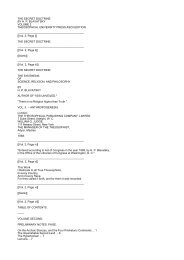You also want an ePaper? Increase the reach of your titles
YUMPU automatically turns print PDFs into web optimized ePapers that Google loves.
The Doctrine Of Eternal Life.<br />
Tmu-Ra, i.e., he existed before Osiris and <strong>the</strong> o<strong>the</strong>r gods <strong>of</strong> his company. These two passages prove <strong>the</strong><br />
identity <strong>of</strong> <strong>the</strong> belief in eternal life in <strong>the</strong> XVIIIth dynasty with that in <strong>the</strong> Vth and VIth dynasties.<br />
But while we have this evidence <strong>of</strong> <strong>the</strong> Egyptian belief in eternal life, we are nowhere told that man's<br />
corruptible body will rise again; indeed, <strong>the</strong> following extracts show that <strong>the</strong> idea prevailed that <strong>the</strong> body<br />
lay in <strong>the</strong> earth while <strong>the</strong> soul or spirit lived in heaven.<br />
1. ba ar pet sat ar ta<br />
Soul to heaven, body to earth.[4] (Vth dynasty.)<br />
[1. Recueil de Travaux, t. v., p. 170 (Pepi, 1. 85).<br />
2. ###. Plate XIX., l. 16 (<strong>Book</strong> <strong>of</strong> <strong>the</strong> <strong>Dead</strong>, Chapter CLXXV.).<br />
3. Plate XXVIII., 1. 15.<br />
4 Recueil de Travaux, t. iv., p. 71 (l. 582).]<br />
{p. lvii}<br />
2. mu-k er pet xa-k er ta<br />
Thy essence is in heaven, thy body to earth.[1] (VIth dynasty.)<br />
3. pet xer ba-k ta xeri tut-k<br />
Heaven hath thy soul, earth hath thy body.[2] (Ptolemaic period.)<br />
Constancy in <strong>the</strong> belief in <strong>the</strong> resurrection.<br />
There is, however, no doubt that from first to last <strong>the</strong> Egyptians firmly believed that besides <strong>the</strong> soul<br />
<strong>the</strong>re was some o<strong>the</strong>r element <strong>of</strong> <strong>the</strong> man that would rise again. The preservation <strong>of</strong> <strong>the</strong> corruptible body<br />
too was in some way connected with <strong>the</strong> life in <strong>the</strong> world to come, and its preservation was necessary to<br />
ensure eternal life; o<strong>the</strong>rwise <strong>the</strong> prayers recited to this end would have been futile, and <strong>the</strong> time<br />
honoured custom <strong>of</strong> mummifying <strong>the</strong> dead would have had no meaning. The never ending existence <strong>of</strong><br />
<strong>the</strong> soul is asserted in a passage quoted above without reference to Osiris; but <strong>the</strong> frequent mention <strong>of</strong> <strong>the</strong><br />
uniting <strong>of</strong> his bones, and <strong>of</strong> <strong>the</strong> ga<strong>the</strong>ring toge<strong>the</strong>r <strong>of</strong> his members,[3] and <strong>the</strong> doing away with all<br />
corruption from his body, seems to show that <strong>the</strong> pious Egyptian connected <strong>the</strong>se things with <strong>the</strong><br />
resurrection <strong>of</strong> his own body in some form, and he argued that what had been done for him who was<br />
proclaimed to be giver and source <strong>of</strong> life must be necessary for mortal man.<br />
The khat or physical body.<br />
The physical body <strong>of</strong> man considered as a whole was called khat, a word which seems to be connected<br />
with <strong>the</strong> idea <strong>of</strong> something which is liable to decay. The word is also applied to <strong>the</strong> mummified body in<br />
<strong>the</strong> tomb, as we know from <strong>the</strong> words "My body (khat) is buried."[4] Such a body was attributed to <strong>the</strong><br />
god Osiris;" in <strong>the</strong> CLXIInd Chapter <strong>of</strong> <strong>the</strong> <strong>Book</strong> <strong>of</strong> <strong>the</strong> <strong>Dead</strong> "his great<br />
[1. Recueil de Travaux, t. v., p. 43 (l. 304).<br />
2. Horrack, Lamentations d'Isis et de Nephthys, Paris, 1866, p. 6.<br />
3. Already in <strong>the</strong> pyramid texts we have "Rise up, O thou Teta! Thou hast received thy head, thou hast knitted toge<strong>the</strong>r thy<br />
http://www.sacred-texts.com/egy/ebod/ebod05.htm (3 <strong>of</strong> 21) [8/10/2001 11:23:20 AM]

















